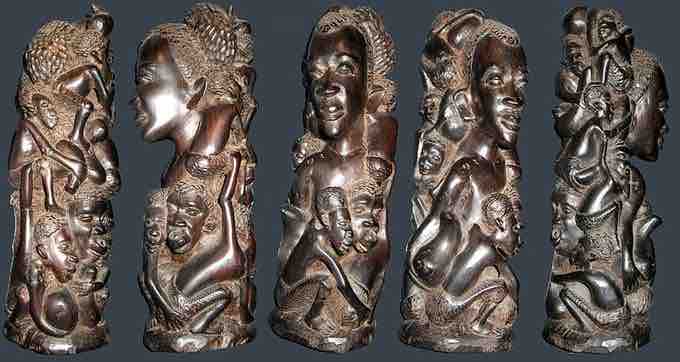Background
Like all human cultures, African folklore and religion is diverse and varied. Culture and spirituality share space and are deeply intertwined in most African cultures, which have been heavily influenced by the introduction of Christianity and Islam during the era of European colonization. Most traditional African cultures include beliefs about the spirit world, which is widely represented through both traditional and modern art such as masks, statues, and sculptures. In some societies, artistic talents were themselves seen as ways to please higher spirits.
Traditional Influences on Contemporary Religious Art
Masks and Rituals
Wooden masks, which often take the form of animals, humans, or mythical creatures, are one of the most commonly found forms of traditional art in western Africa. These masks are often used to depict deities or represent the souls of the departed. They may be worn by a dancer in ceremonies for celebrations, deaths, initiations, or crop harvesting. In many traditional mask ceremonies, the dancer goes into deep trance, and during this state of mind he or she is believed to communicate with ancestors in the spirit world. The masks themselves often represent an ancestral spirit, which is believed to possess the wearer of the mask. Most African masks are made with wood and can also be decorated with ivory, animal hair, plant fibers, pigments, stones, and semi-precious gems.

Mask from Gabon
A traditional mask from Gabon.
Statues and sculptures are also used to represent or connect to spiritual forces. For example, Bambara statuettes, such as the Chiwara, are used as spiritually charged objects during ritual. During the annual ceremonies of the Guan society, a group of up to seven figures, some dating back to the 14th century, are removed from their sanctuaries by the elder members of the society. The wooden sculptures, which represent a highly stylized animal or human figure, are washed, re-oiled and offered sacrifices. The Kono and Komo societies use similar statues to serve as receptacles for spiritual forces. The Igbo would traditionally make clay altars and shrines of their deities, usually featuring various figures. In the Kingdom of Kongo, nkisi were objects believed to be inhabited by spirits. Often carved in the shape of animals or humans, these "power objects" were believed to help aid in the communication with the spirit world.
Modern Religion
Today, the countries of Africa contain a wide variety of religious beliefs, and statistics on religious affiliation are difficult to come by. Christianity and Islam make up the largest religions in contemporary Africa, and some sources say that less than 15% still follow traditional African religions. Despite the drastic decrease in native African religions, some modern art in Africa has worked to reincorporate traditional spiritual beliefs. For example, modern Makonde Art has turned to abstract figures in which spirits, or Shetani, play an important role.

Modern Makonde carving in ebony
Modern Makonde sculptures often depict spirits, or Shetani.